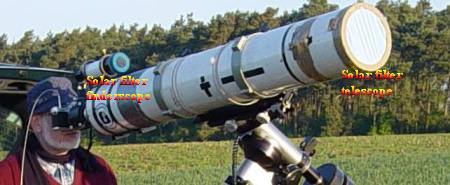|
|
Venus2004.org
> Files
3°)Material needed and advice for the observations
A)Needed material for both observations: A telescope: A telescope is needed for this observation, it is not possible to use only «Eclipse eyeglasses». This telescope should have a diameter of at least 50 millimeters ( +/- 2 inches ). In all cases the telescope MUST be used with a solar filter correctly set at the open side of the telescope. DO NOT SET THE FILTER ON THE EYE PIECE ! If you have any doubs, please contact a accredited astronomy store. If your telescope is equipped with a finderscope, this finderscope MUST be used with a solar filter set the same way as your telescope. CAUTION: Observing the sun can be very dangerous, therefore the safety precautions MUST be respected, see: http://www.venus2004.org/sinformer/n/news3366.php?langue=1  Telescope and finderscope equipped with solar filters, credits: SC, Venus2004.org The observation methodology can be: Direct: Observing directly in the eye piece. A projection: Projecting the picture on a white surface. This methodology is not recommended. It will be difficult to get accurate results because the sun will constantly leave the field of observation. You will have to move the white surface ( screen ) continuously. The size of the picture will be influenced by the moving of the screen. This methodology can only be used for the chronometrical process. The telescope has to adapt its inside temperature to the ambient temperature. To minimize the air turbulence inside the telescope it is recommended to install the telescope at the observation site at least two hours before the transit. Eyepieces : Do not forget to take your eyepieces and barlow lens. They will be useful to observe the black drop and also for the rest of the transit. A wide field eyepiece will be very useful if you’ll be using a digital camera. Miscellaneous material : The duration of this transit will be quite long. A little bit of comfort would increase the quality of the show. A chair, drinks, food.. Sun protection, hat.. are also recommended. Protection against the wind would be helpful if you have to use high magnification during windy conditions. B)Material needed for the chronometrical methodology : A international atomic clock : The use of an international atomic clock is needed for the accuracy of the measurements. If you don’t have this item but someone near you has one, you can use a chronometer. The chronometer has to be set with the international atomic clock few minutes before the contact moment measurements. Miscellaneous material : A few sheets of paper to write down your measurements. Something to write with. We recommend you prepare your observation sheet in advance. Then you’ll only have to fill in the measured values during the transit. C)Material needed for the photographic methodology: A photographic camera: A photographic camera is needed for this methodology. It can be: A traditional one: You’ll have to set it at the focal point of your telescope using a special adapter ring ( T2 or other ) Do not forget to load the film (it has been known to happen). Digital: Two kinds of digital cameras can be bought. Either with a removable zoom lens which can be adapted to the focal point of your telescope or with a fixed zoom lens. In the latter case you’ll have to use the lens holding it on your eyepiece. You can also buy a special adapter to adapt it on a eyepiece. Without this adapter the pictures's accuracy will not be as good, depending on your ability to hold the camera manually on the eyepiece. The webcam: To photograph half of the sun, the webcam should be used with a focal reducer. The quality of the picture will be poorer than for a digital camera because of the number of pixels. A webcam ccd contains less pixels than a digital camera. However, a webcam can give you very good results if Venus progresses next to a sunspot. Miscellaneous material: A few sheets of paper to write down the different moments when the pictures are taken. |
|
© 2003-2006 Futura-Sciences.com. All rights reserved.
Indexator - Comparateur de prix - Revue de Presse
